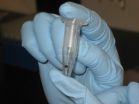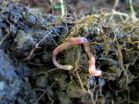(Press-News.org) Birds in the crow family can figure out how to extract a treat from a half-empty glass surprisingly well, and young children show similar patterns of behavior until they reach about eight years old, at which point their performance surpasses that of the birds. The full report is published July 25 in the open access journal PLoS ONE.
In the current study, led by Nicola Clayton of the University of Cambridge, researchers used a version of the riddle commonly referred to as "Aesop's fable" to test associative learning and problem-solving ability. In previous work, the researchers presented the birds with a partially filled glass of water, with a worm floating just out of reach. The birds were also offered different tools, like rocks or Styrofoam blocks, and were able to figure out which items, when dropped into the glass, would cause the water level to rise so that they could reach the treat.
In the current paper, the researchers tested the ability of children between the ages of four and ten on a similar task: retrieving a floating token in a number of different scenarios. The researchers found that children between the ages of five and seven performed consistently with the birds; both learned how to accomplish the task after about 5 trials. Children eight years and older succeeded in all tasks on their first try.
According to Lucy Cheke, first author of the publication, the main purpose of the study was to see whether birds and children learn in the same way. She says that, based on the results, it seems they don't: the birds were unable to learn when something apparently impossible happened, while children were able to learn about what was happening even if they had no idea how it was happening. "It is children's job to learn about the world," Cheke says, "and they can't do that when they are limited by a preconceived idea about what is or is not possible. For a child, if it works, it works."
INFORMATION:
Citation: Cheke LG, Loissel E, Clayton NS (2012) How Do Children Solve Aesop's Fable? PLoS ONE 7(7): e40574. doi:10.1371/journal.pone.0040574
Financial Disclosure: The authors have no support or funding to report.
Competing Interest Statement: The authors have declared that no competing interests exist.
PLEASE LINK TO THE SCIENTIFIC ARTICLE IN ONLINE VERSIONS OF YOUR REPORT (URL goes live after the embargo ends):
http://dx.plos.org/10.1371/journal.pone.0040574
Disclaimer: This press release refers to upcoming articles in PLoS ONE. The releases have been provided by the article authors and/or journal staff. Any opinions expressed in these are the personal views of the contributors, and do not necessarily represent the views or policies of PLOS. PLOS expressly disclaims any and all warranties and liability in connection with the information found in the release and article and your use of such information.
About PLoS ONE
PLoS ONE is the first journal of primary research from all areas of science to employ a combination of peer review and post-publication rating and commenting, to maximize the impact of every report it publishes. PLoS ONE is published by the Public Library of Science (PLOS), the open-access publisher whose goal is to make the world's scientific and medical literature a public resource.
All works published in PLoS ONE are Open Access. Everything is immediately available—to read, download, redistribute, include in databases and otherwise use—without cost to anyone, anywhere, subject only to the condition that the original authors and source are properly attributed. For more information about PLoS ONE relevant to journalists, bloggers and press officers, including details of our press release process and our embargo policy, see the everyONE blog at http://everyone.plos.org/media.
END
STONY BROOK and NEW YORK, NY– Research that used mitochondrial DNA-based testing to compare the extent of fraudulent labeling of black caviar purchased before and after international protection shows conservation benefits. A team of scientists from the Institute for Conservation Science at Stony Brook University and the Sackler Institute for Comparative Genomics at the American Museum of Natural History (AMNH) repeated a market survey of commercially available caviar in the New York City area that was conducted before the protection was put in place, and the results showed ...
While some published research has hinted at the connection between the sickle cell trait and sudden cardiac death among young, athletic African-American males, which was initially observed in black military recruits 25 years ago, a new study with the first sizeable patient series definitively confirms this risk for these individuals during competitive sports.
The sickle cell trait, for which all U.S. African Americans are tested at birth, affects approximately 8 percent of the population. The Minneapolis Heart Institute Foundation maintains a 32-year-old forensic database, ...
Scientists have discovered a thriving population of Mediterranean earthworms in an urban farm in Dublin, Ireland.
The findings by University College Dublin scientists published in the journal Biology Letters on 25 July 2012 suggest that rising soil temperatures due to climate change may be extending the geographical habitat range of the earthworm Prosellodrilus amplisetosus.
"Soil decomposer species including earthworms are frequently introduced into non-native soils by human activities like the transportation of nursery plants or live fish bait," says Dr Olaf Schmidt ...
Boston, MA ─ A new study from Harvard School of Public Health (HSPH) finds that expanding Medicaid to low-income adults leads to widespread gains in coverage, access to care, and—most importantly—improved health and reduced mortality. It is the first published study to look specifically at the effect of recent state Medicaid expansions on mortality among low-income adults, and the findings suggest that expanding coverage to the uninsured may save lives.
"The recent Supreme Court decision on the Affordable Care Act ruled that states could decide whether or not they ...
A team of University of California, Berkeley, scientists in collaboration with researchers at the University of Munich and University of Washington in Seattle has discovered a chemical that temporarily restores some vision to blind mice, and is working on an improved compound that may someday allow people with degenerative blindness to see again.
The approach could eventually help those with retinitis pigmentosa, a genetic disease that is the most common inherited form of blindness, as well as age-related macular degeneration, the most common cause of acquired blindness ...
HACKENSACK, N.J. (July 25, 2012) — Researchers from John Theurer Cancer Center at HackensackUMC, one of the nation's 50 best hospitals for cancer, played leading roles in three separate multi-center studies with the new proteasome inhibitor carfilzomib published in Blood, a major peer-reviewed scientific journal.
Carfilzomib is a novel, highly selective proteasome inhibitor, a type of medication that blocks the actions of certain proteins (proteasomes) that cancer cells need to survive and multiply. Carfilzomib is also known by its branded name Kyprolis™.
On July ...
Adding computed tomography (CT) scans to standard screening procedures may help emergency room staff more rapidly determine which patients complaining of chest pain are having a heart attack or may soon have a heart attack, and which patients can be safely discharged, according to a study funded by the National Heart, Lung, and Blood Institute (NHLBI), part of the National Institutes of Health.
Researchers in the study focused on a condition known as acute coronary syndrome, which includes heart attacks and unstable angina (chest pain), a condition that often progresses ...
Newport, R.I., July 25, 2012 - Migraine can be a disabling neurological disorder, often aggravated by accompanying nausea. Stimulation of the acupoint PC6 Neiguan, an approach to controlling nausea adopted by traditional Chinese medicine, has never been documented by published clinical studies in medical literature for the control of migraine-related nausea, until now. Published in the May 2012 Neurological Sciences (journal of the Italian Neurological Society)*, "Acupressure in the control of migraine-associated nausea" is a clinical trial demonstrating that continuous ...
In a quest to make safer and more effective vaccines, scientists at the Biodesign InstituteÒ at Arizona State University have turned to a promising field called DNA nanotechnology to make an entirely new class of synthetic vaccines.
In a study published in the journal Nano Letters, Biodesign immunologist Yung Chang joined forces with her colleagues, including DNA nanotechnology innovator Hao Yan, to develop the first vaccine complex that could be delivered safely and effectively by piggybacking onto self-assembled, three-dimensional DNA nanostructures.
"When Hao treated ...
Cognition psychologists at the Ruhr-Universität together with colleagues from the University Hospital Bergmannsheil (Prof. Dr. Martin Tegenthoff) have discovered why stressed persons are more likely to lapse back into habits than to behave goal-directed. The team of PD Dr. Lars Schwabe and Prof. Dr. Oliver Wolf from the Institute for Cognitive Neuroscience have mimicked a stress situation in the body using drugs. They then examined the brain activity using functional MRI scanning. The researchers have now reported in the Journal of Neuroscience that the interaction of the ...


